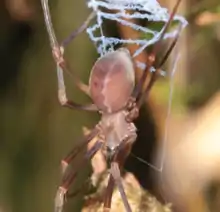| Progradungula | |
|---|---|
 | |
| P. otwayensis | |
| Scientific classification | |
| Domain: | Eukaryota |
| Kingdom: | Animalia |
| Phylum: | Arthropoda |
| Subphylum: | Chelicerata |
| Class: | Arachnida |
| Order: | Araneae |
| Infraorder: | Araneomorphae |
| Family: | Gradungulidae |
| Genus: | Progradungula Forster & Gray, 1979[1] |
| Type species | |
| P. carraiensis Forster & Gray, 1979 | |
| Species | |
| |
Progradungula is a genus of Australian large-clawed spiders that was first described by Raymond Robert Forster and Michael R. Gray in 1979.[2] As of May 2019 it contains only two species: P. carraiensis and P. otwayensis.[1]
The name is derived from Latin pro ("before"), and the genus name Gradungula, referring to the ancient ancestry of the genus. It is the first discovered web-building cribellate spider in a "primitive" araneomorph spider family and helped establish the idea that all araneomorph spiders evolved from cribellate ancestors.[3]
These spiders have an uncommon web-making technique and prey-capturing behaviour. A small (approximately 25 by 6 mm), tilting, ladder-like platform of cribellate capturing silk is supported by an overhead structure of threads linked to the rock walls and consists of two parallel stabilizing silk lines.
References
- 1 2 "Gen. Progradungula Forster & Gray, 1979". World Spider Catalog Version 20.0. Natural History Museum Bern. 2019. doi:10.24436/2. Retrieved 2019-06-07.
- ↑ Forster, R. R.; Gray, M. R. (1979). "Progradungula, a new cribellate genus of the spider family Gradungulidae (Araneae)". Australian Journal of Zoology. 27: 1051–1071. doi:10.1071/zo9791051.
- ↑ Milledge, G. (1997). "A new species of Progradungula Forster & Gray (Araneae: Gradungulidae)from Victoria". Mem. Mus. Vic. 56 (1): 65–68. doi:10.24199/j.mmv.1997.56.02.
- ↑ Platnick, Norman I.; Dupérré, Nadine (2010-03-15). "The Goblin Spider Genus Scaphiella (Araneae, Oonopidae)". Bulletin of the American Museum of Natural History. 332: 1–156. doi:10.1206/700.1. ISSN 0003-0090.